An Analysis of Total Reward Systems in Financial and Healthcare
VerifiedAdded on 2020/06/05
|11
|3165
|55
Report
AI Summary
This report provides a comprehensive analysis of total reward systems, exploring their concepts, components, and effectiveness within the financial services and healthcare sectors. It begins with an introduction to total reward systems, emphasizing their role in employee motivation and organizational objectives. The main body delves into the concept of total rewards, differentiating between financial and non-financial rewards, and examines how these systems align with motivational theories such as Maslow's hierarchy of needs, Alderfer's ERG theory, and Herzberg's two-factor theory. The report then evaluates the effectiveness of total reward systems within the financial and healthcare sectors, discussing compensation, benefits, recognition, and employee development strategies. It highlights the unique challenges and opportunities in each sector, considering factors like performance-based pay, employee retention, and the importance of aligning rewards with organizational culture and values. The report concludes with a summary of the key findings and implications for organizations aiming to implement or enhance their reward systems.
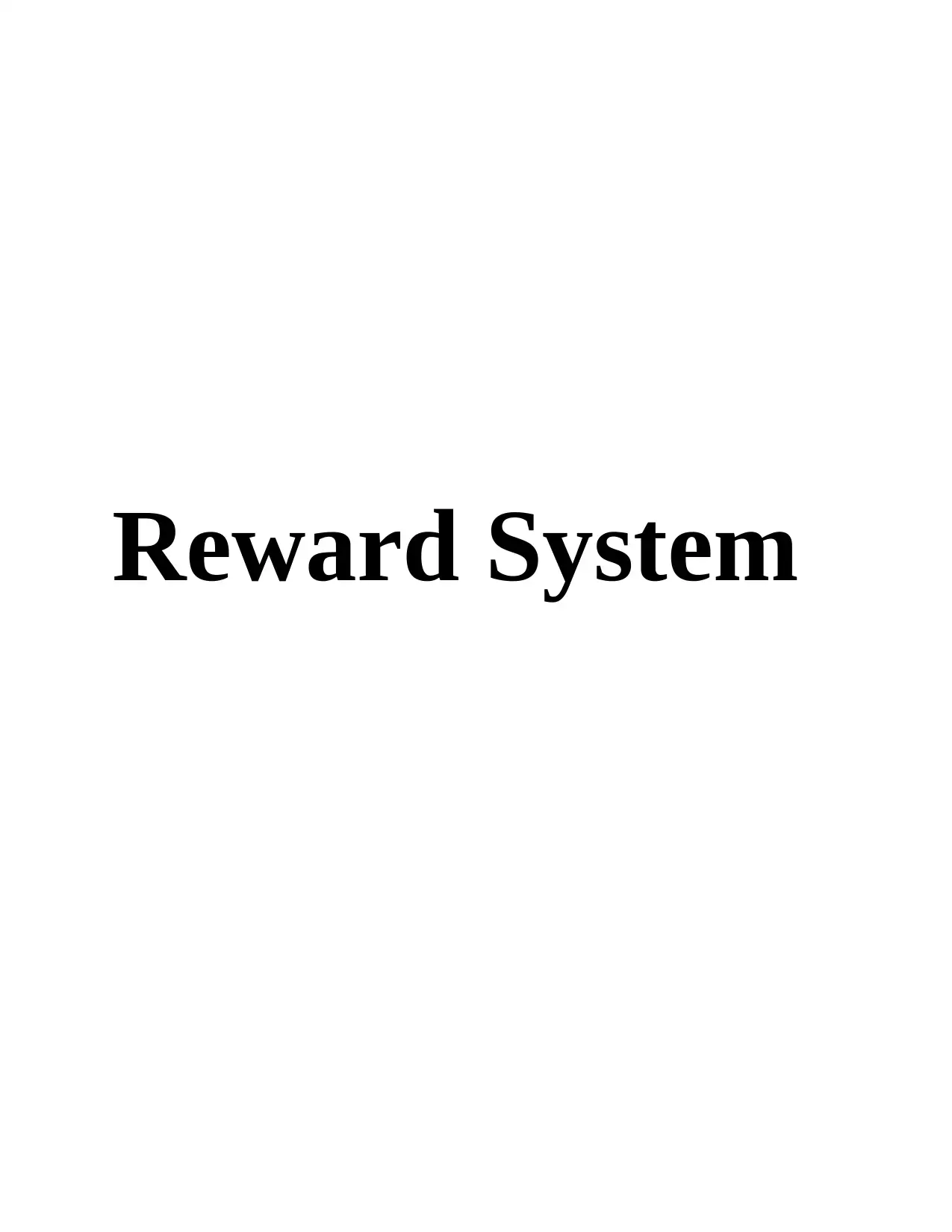
Reward System
Paraphrase This Document
Need a fresh take? Get an instant paraphrase of this document with our AI Paraphraser

Table of Contents
INTRODUCTION...........................................................................................................................1
Main body .......................................................................................................................................1
CONCLUSION................................................................................................................................7
REFERENCES................................................................................................................................8
INTRODUCTION...........................................................................................................................1
Main body .......................................................................................................................................1
CONCLUSION................................................................................................................................7
REFERENCES................................................................................................................................8
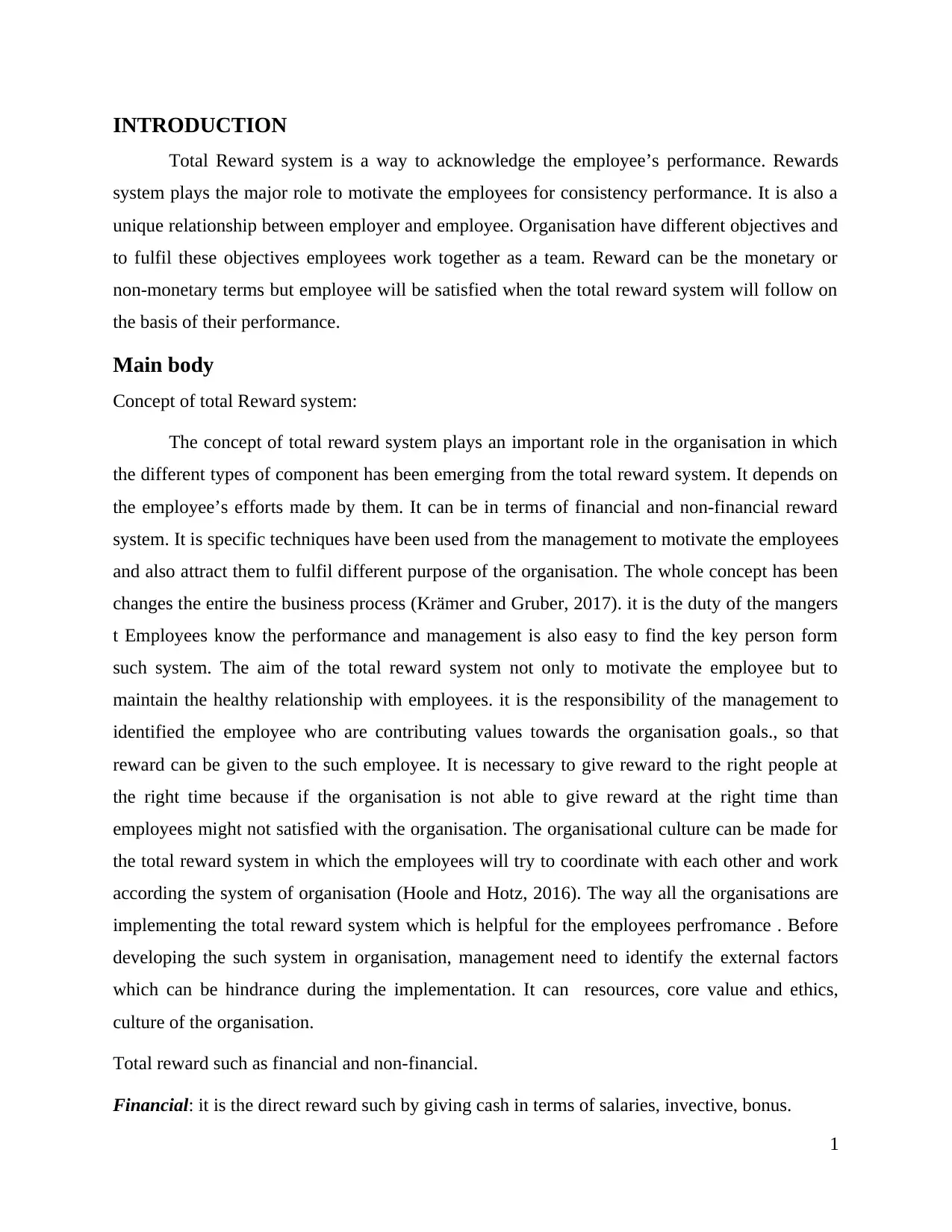
INTRODUCTION
Total Reward system is a way to acknowledge the employee’s performance. Rewards
system plays the major role to motivate the employees for consistency performance. It is also a
unique relationship between employer and employee. Organisation have different objectives and
to fulfil these objectives employees work together as a team. Reward can be the monetary or
non-monetary terms but employee will be satisfied when the total reward system will follow on
the basis of their performance.
Main body
Concept of total Reward system:
The concept of total reward system plays an important role in the organisation in which
the different types of component has been emerging from the total reward system. It depends on
the employee’s efforts made by them. It can be in terms of financial and non-financial reward
system. It is specific techniques have been used from the management to motivate the employees
and also attract them to fulfil different purpose of the organisation. The whole concept has been
changes the entire the business process (Krämer and Gruber, 2017). it is the duty of the mangers
t Employees know the performance and management is also easy to find the key person form
such system. The aim of the total reward system not only to motivate the employee but to
maintain the healthy relationship with employees. it is the responsibility of the management to
identified the employee who are contributing values towards the organisation goals., so that
reward can be given to the such employee. It is necessary to give reward to the right people at
the right time because if the organisation is not able to give reward at the right time than
employees might not satisfied with the organisation. The organisational culture can be made for
the total reward system in which the employees will try to coordinate with each other and work
according the system of organisation (Hoole and Hotz, 2016). The way all the organisations are
implementing the total reward system which is helpful for the employees perfromance . Before
developing the such system in organisation, management need to identify the external factors
which can be hindrance during the implementation. It can resources, core value and ethics,
culture of the organisation.
Total reward such as financial and non-financial.
Financial: it is the direct reward such by giving cash in terms of salaries, invective, bonus.
1
Total Reward system is a way to acknowledge the employee’s performance. Rewards
system plays the major role to motivate the employees for consistency performance. It is also a
unique relationship between employer and employee. Organisation have different objectives and
to fulfil these objectives employees work together as a team. Reward can be the monetary or
non-monetary terms but employee will be satisfied when the total reward system will follow on
the basis of their performance.
Main body
Concept of total Reward system:
The concept of total reward system plays an important role in the organisation in which
the different types of component has been emerging from the total reward system. It depends on
the employee’s efforts made by them. It can be in terms of financial and non-financial reward
system. It is specific techniques have been used from the management to motivate the employees
and also attract them to fulfil different purpose of the organisation. The whole concept has been
changes the entire the business process (Krämer and Gruber, 2017). it is the duty of the mangers
t Employees know the performance and management is also easy to find the key person form
such system. The aim of the total reward system not only to motivate the employee but to
maintain the healthy relationship with employees. it is the responsibility of the management to
identified the employee who are contributing values towards the organisation goals., so that
reward can be given to the such employee. It is necessary to give reward to the right people at
the right time because if the organisation is not able to give reward at the right time than
employees might not satisfied with the organisation. The organisational culture can be made for
the total reward system in which the employees will try to coordinate with each other and work
according the system of organisation (Hoole and Hotz, 2016). The way all the organisations are
implementing the total reward system which is helpful for the employees perfromance . Before
developing the such system in organisation, management need to identify the external factors
which can be hindrance during the implementation. It can resources, core value and ethics,
culture of the organisation.
Total reward such as financial and non-financial.
Financial: it is the direct reward such by giving cash in terms of salaries, invective, bonus.
1
⊘ This is a preview!⊘
Do you want full access?
Subscribe today to unlock all pages.

Trusted by 1+ million students worldwide
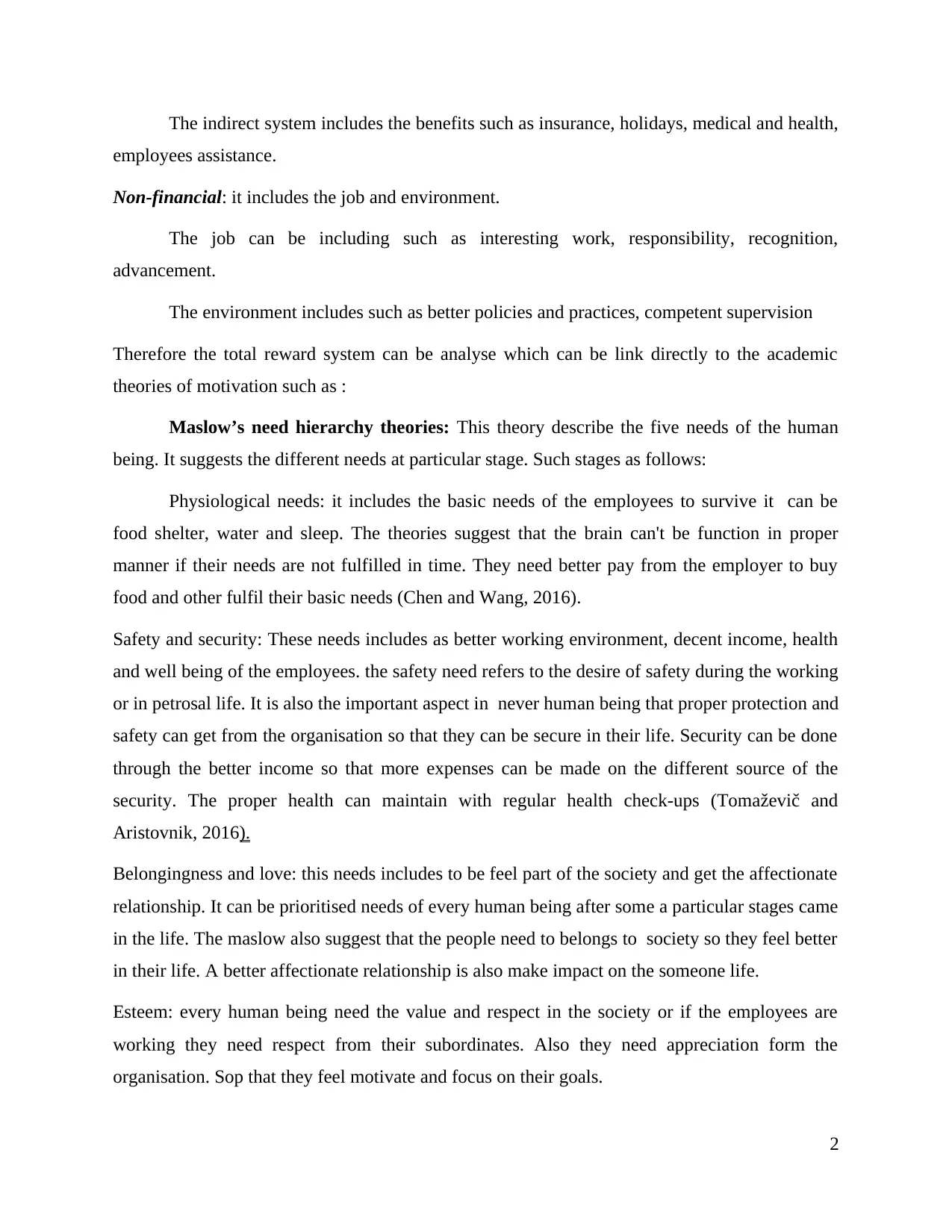
The indirect system includes the benefits such as insurance, holidays, medical and health,
employees assistance.
Non-financial: it includes the job and environment.
The job can be including such as interesting work, responsibility, recognition,
advancement.
The environment includes such as better policies and practices, competent supervision
Therefore the total reward system can be analyse which can be link directly to the academic
theories of motivation such as :
Maslow’s need hierarchy theories: This theory describe the five needs of the human
being. It suggests the different needs at particular stage. Such stages as follows:
Physiological needs: it includes the basic needs of the employees to survive it can be
food shelter, water and sleep. The theories suggest that the brain can't be function in proper
manner if their needs are not fulfilled in time. They need better pay from the employer to buy
food and other fulfil their basic needs (Chen and Wang, 2016).
Safety and security: These needs includes as better working environment, decent income, health
and well being of the employees. the safety need refers to the desire of safety during the working
or in petrosal life. It is also the important aspect in never human being that proper protection and
safety can get from the organisation so that they can be secure in their life. Security can be done
through the better income so that more expenses can be made on the different source of the
security. The proper health can maintain with regular health check-ups (Tomaževič and
Aristovnik, 2016).
Belongingness and love: this needs includes to be feel part of the society and get the affectionate
relationship. It can be prioritised needs of every human being after some a particular stages came
in the life. The maslow also suggest that the people need to belongs to society so they feel better
in their life. A better affectionate relationship is also make impact on the someone life.
Esteem: every human being need the value and respect in the society or if the employees are
working they need respect from their subordinates. Also they need appreciation form the
organisation. Sop that they feel motivate and focus on their goals.
2
employees assistance.
Non-financial: it includes the job and environment.
The job can be including such as interesting work, responsibility, recognition,
advancement.
The environment includes such as better policies and practices, competent supervision
Therefore the total reward system can be analyse which can be link directly to the academic
theories of motivation such as :
Maslow’s need hierarchy theories: This theory describe the five needs of the human
being. It suggests the different needs at particular stage. Such stages as follows:
Physiological needs: it includes the basic needs of the employees to survive it can be
food shelter, water and sleep. The theories suggest that the brain can't be function in proper
manner if their needs are not fulfilled in time. They need better pay from the employer to buy
food and other fulfil their basic needs (Chen and Wang, 2016).
Safety and security: These needs includes as better working environment, decent income, health
and well being of the employees. the safety need refers to the desire of safety during the working
or in petrosal life. It is also the important aspect in never human being that proper protection and
safety can get from the organisation so that they can be secure in their life. Security can be done
through the better income so that more expenses can be made on the different source of the
security. The proper health can maintain with regular health check-ups (Tomaževič and
Aristovnik, 2016).
Belongingness and love: this needs includes to be feel part of the society and get the affectionate
relationship. It can be prioritised needs of every human being after some a particular stages came
in the life. The maslow also suggest that the people need to belongs to society so they feel better
in their life. A better affectionate relationship is also make impact on the someone life.
Esteem: every human being need the value and respect in the society or if the employees are
working they need respect from their subordinates. Also they need appreciation form the
organisation. Sop that they feel motivate and focus on their goals.
2
Paraphrase This Document
Need a fresh take? Get an instant paraphrase of this document with our AI Paraphraser
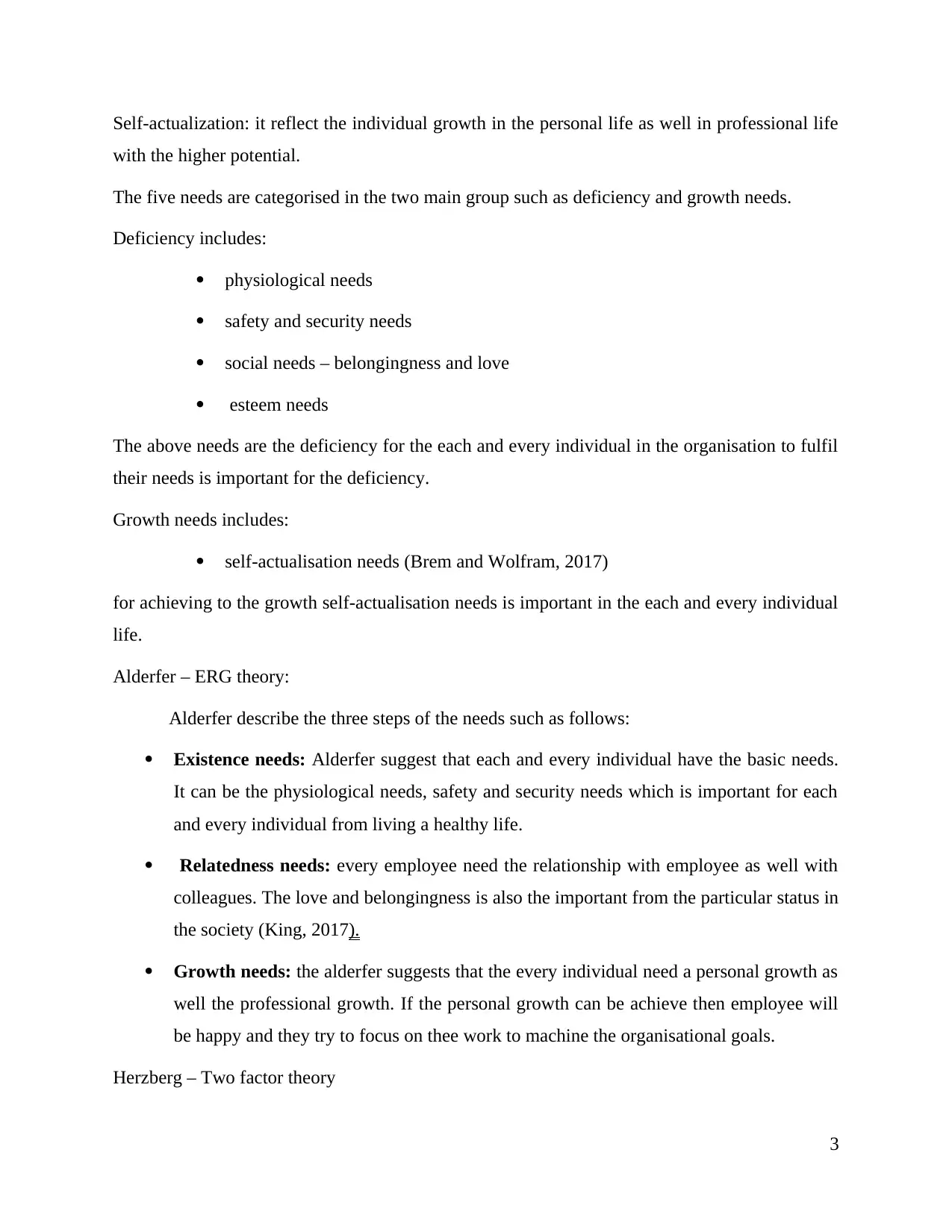
Self-actualization: it reflect the individual growth in the personal life as well in professional life
with the higher potential.
The five needs are categorised in the two main group such as deficiency and growth needs.
Deficiency includes:
physiological needs
safety and security needs
social needs – belongingness and love
esteem needs
The above needs are the deficiency for the each and every individual in the organisation to fulfil
their needs is important for the deficiency.
Growth needs includes:
self-actualisation needs (Brem and Wolfram, 2017)
for achieving to the growth self-actualisation needs is important in the each and every individual
life.
Alderfer – ERG theory:
Alderfer describe the three steps of the needs such as follows:
Existence needs: Alderfer suggest that each and every individual have the basic needs.
It can be the physiological needs, safety and security needs which is important for each
and every individual from living a healthy life.
Relatedness needs: every employee need the relationship with employee as well with
colleagues. The love and belongingness is also the important from the particular status in
the society (King, 2017).
Growth needs: the alderfer suggests that the every individual need a personal growth as
well the professional growth. If the personal growth can be achieve then employee will
be happy and they try to focus on thee work to machine the organisational goals.
Herzberg – Two factor theory
3
with the higher potential.
The five needs are categorised in the two main group such as deficiency and growth needs.
Deficiency includes:
physiological needs
safety and security needs
social needs – belongingness and love
esteem needs
The above needs are the deficiency for the each and every individual in the organisation to fulfil
their needs is important for the deficiency.
Growth needs includes:
self-actualisation needs (Brem and Wolfram, 2017)
for achieving to the growth self-actualisation needs is important in the each and every individual
life.
Alderfer – ERG theory:
Alderfer describe the three steps of the needs such as follows:
Existence needs: Alderfer suggest that each and every individual have the basic needs.
It can be the physiological needs, safety and security needs which is important for each
and every individual from living a healthy life.
Relatedness needs: every employee need the relationship with employee as well with
colleagues. The love and belongingness is also the important from the particular status in
the society (King, 2017).
Growth needs: the alderfer suggests that the every individual need a personal growth as
well the professional growth. If the personal growth can be achieve then employee will
be happy and they try to focus on thee work to machine the organisational goals.
Herzberg – Two factor theory
3
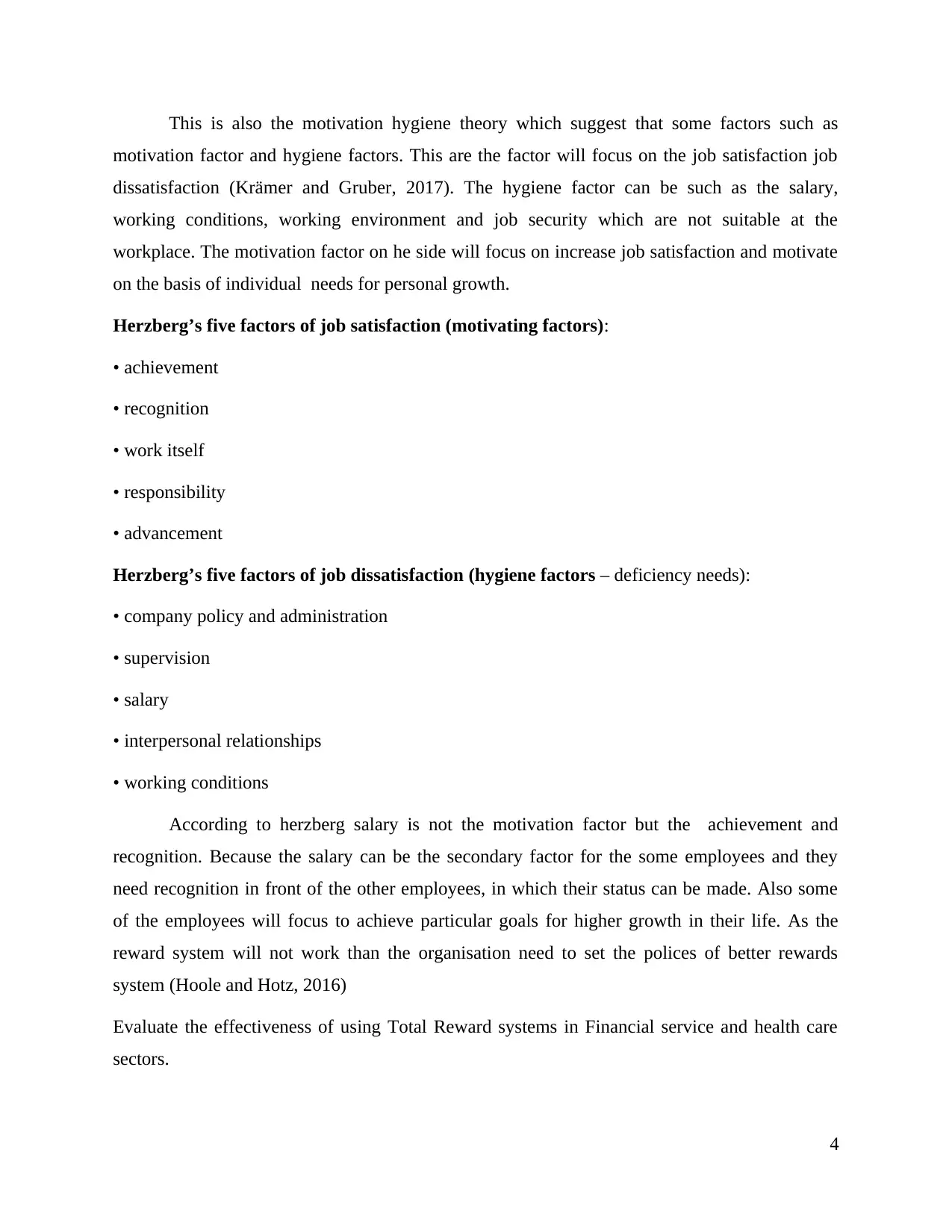
This is also the motivation hygiene theory which suggest that some factors such as
motivation factor and hygiene factors. This are the factor will focus on the job satisfaction job
dissatisfaction (Krämer and Gruber, 2017). The hygiene factor can be such as the salary,
working conditions, working environment and job security which are not suitable at the
workplace. The motivation factor on he side will focus on increase job satisfaction and motivate
on the basis of individual needs for personal growth.
Herzberg’s five factors of job satisfaction (motivating factors):
• achievement
• recognition
• work itself
• responsibility
• advancement
Herzberg’s five factors of job dissatisfaction (hygiene factors – deficiency needs):
• company policy and administration
• supervision
• salary
• interpersonal relationships
• working conditions
According to herzberg salary is not the motivation factor but the achievement and
recognition. Because the salary can be the secondary factor for the some employees and they
need recognition in front of the other employees, in which their status can be made. Also some
of the employees will focus to achieve particular goals for higher growth in their life. As the
reward system will not work than the organisation need to set the polices of better rewards
system (Hoole and Hotz, 2016)
Evaluate the effectiveness of using Total Reward systems in Financial service and health care
sectors.
4
motivation factor and hygiene factors. This are the factor will focus on the job satisfaction job
dissatisfaction (Krämer and Gruber, 2017). The hygiene factor can be such as the salary,
working conditions, working environment and job security which are not suitable at the
workplace. The motivation factor on he side will focus on increase job satisfaction and motivate
on the basis of individual needs for personal growth.
Herzberg’s five factors of job satisfaction (motivating factors):
• achievement
• recognition
• work itself
• responsibility
• advancement
Herzberg’s five factors of job dissatisfaction (hygiene factors – deficiency needs):
• company policy and administration
• supervision
• salary
• interpersonal relationships
• working conditions
According to herzberg salary is not the motivation factor but the achievement and
recognition. Because the salary can be the secondary factor for the some employees and they
need recognition in front of the other employees, in which their status can be made. Also some
of the employees will focus to achieve particular goals for higher growth in their life. As the
reward system will not work than the organisation need to set the polices of better rewards
system (Hoole and Hotz, 2016)
Evaluate the effectiveness of using Total Reward systems in Financial service and health care
sectors.
4
⊘ This is a preview!⊘
Do you want full access?
Subscribe today to unlock all pages.

Trusted by 1+ million students worldwide
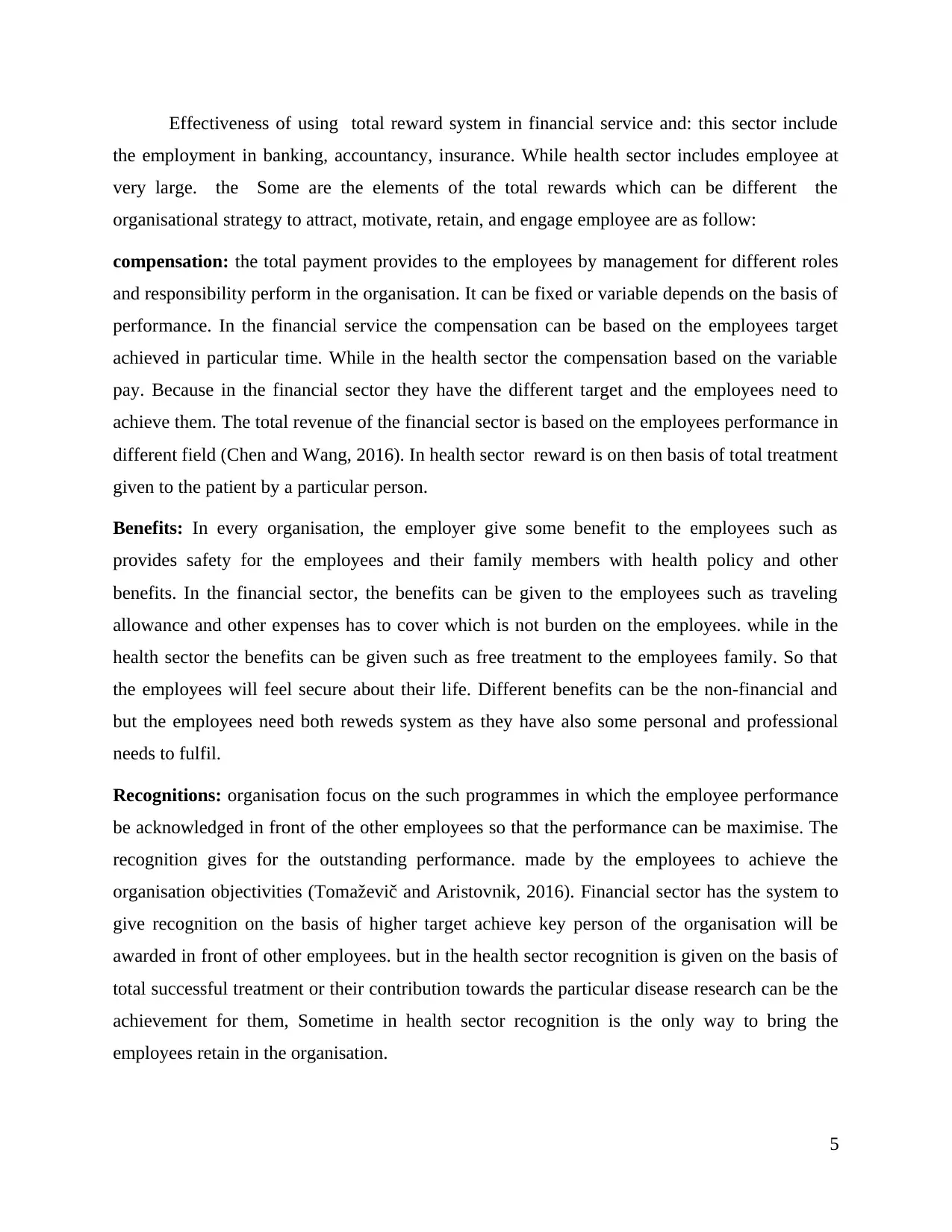
Effectiveness of using total reward system in financial service and: this sector include
the employment in banking, accountancy, insurance. While health sector includes employee at
very large. the Some are the elements of the total rewards which can be different the
organisational strategy to attract, motivate, retain, and engage employee are as follow:
compensation: the total payment provides to the employees by management for different roles
and responsibility perform in the organisation. It can be fixed or variable depends on the basis of
performance. In the financial service the compensation can be based on the employees target
achieved in particular time. While in the health sector the compensation based on the variable
pay. Because in the financial sector they have the different target and the employees need to
achieve them. The total revenue of the financial sector is based on the employees performance in
different field (Chen and Wang, 2016). In health sector reward is on then basis of total treatment
given to the patient by a particular person.
Benefits: In every organisation, the employer give some benefit to the employees such as
provides safety for the employees and their family members with health policy and other
benefits. In the financial sector, the benefits can be given to the employees such as traveling
allowance and other expenses has to cover which is not burden on the employees. while in the
health sector the benefits can be given such as free treatment to the employees family. So that
the employees will feel secure about their life. Different benefits can be the non-financial and
but the employees need both reweds system as they have also some personal and professional
needs to fulfil.
Recognitions: organisation focus on the such programmes in which the employee performance
be acknowledged in front of the other employees so that the performance can be maximise. The
recognition gives for the outstanding performance. made by the employees to achieve the
organisation objectivities (Tomaževič and Aristovnik, 2016). Financial sector has the system to
give recognition on the basis of higher target achieve key person of the organisation will be
awarded in front of other employees. but in the health sector recognition is given on the basis of
total successful treatment or their contribution towards the particular disease research can be the
achievement for them, Sometime in health sector recognition is the only way to bring the
employees retain in the organisation.
5
the employment in banking, accountancy, insurance. While health sector includes employee at
very large. the Some are the elements of the total rewards which can be different the
organisational strategy to attract, motivate, retain, and engage employee are as follow:
compensation: the total payment provides to the employees by management for different roles
and responsibility perform in the organisation. It can be fixed or variable depends on the basis of
performance. In the financial service the compensation can be based on the employees target
achieved in particular time. While in the health sector the compensation based on the variable
pay. Because in the financial sector they have the different target and the employees need to
achieve them. The total revenue of the financial sector is based on the employees performance in
different field (Chen and Wang, 2016). In health sector reward is on then basis of total treatment
given to the patient by a particular person.
Benefits: In every organisation, the employer give some benefit to the employees such as
provides safety for the employees and their family members with health policy and other
benefits. In the financial sector, the benefits can be given to the employees such as traveling
allowance and other expenses has to cover which is not burden on the employees. while in the
health sector the benefits can be given such as free treatment to the employees family. So that
the employees will feel secure about their life. Different benefits can be the non-financial and
but the employees need both reweds system as they have also some personal and professional
needs to fulfil.
Recognitions: organisation focus on the such programmes in which the employee performance
be acknowledged in front of the other employees so that the performance can be maximise. The
recognition gives for the outstanding performance. made by the employees to achieve the
organisation objectivities (Tomaževič and Aristovnik, 2016). Financial sector has the system to
give recognition on the basis of higher target achieve key person of the organisation will be
awarded in front of other employees. but in the health sector recognition is given on the basis of
total successful treatment or their contribution towards the particular disease research can be the
achievement for them, Sometime in health sector recognition is the only way to bring the
employees retain in the organisation.
5
Paraphrase This Document
Need a fresh take? Get an instant paraphrase of this document with our AI Paraphraser
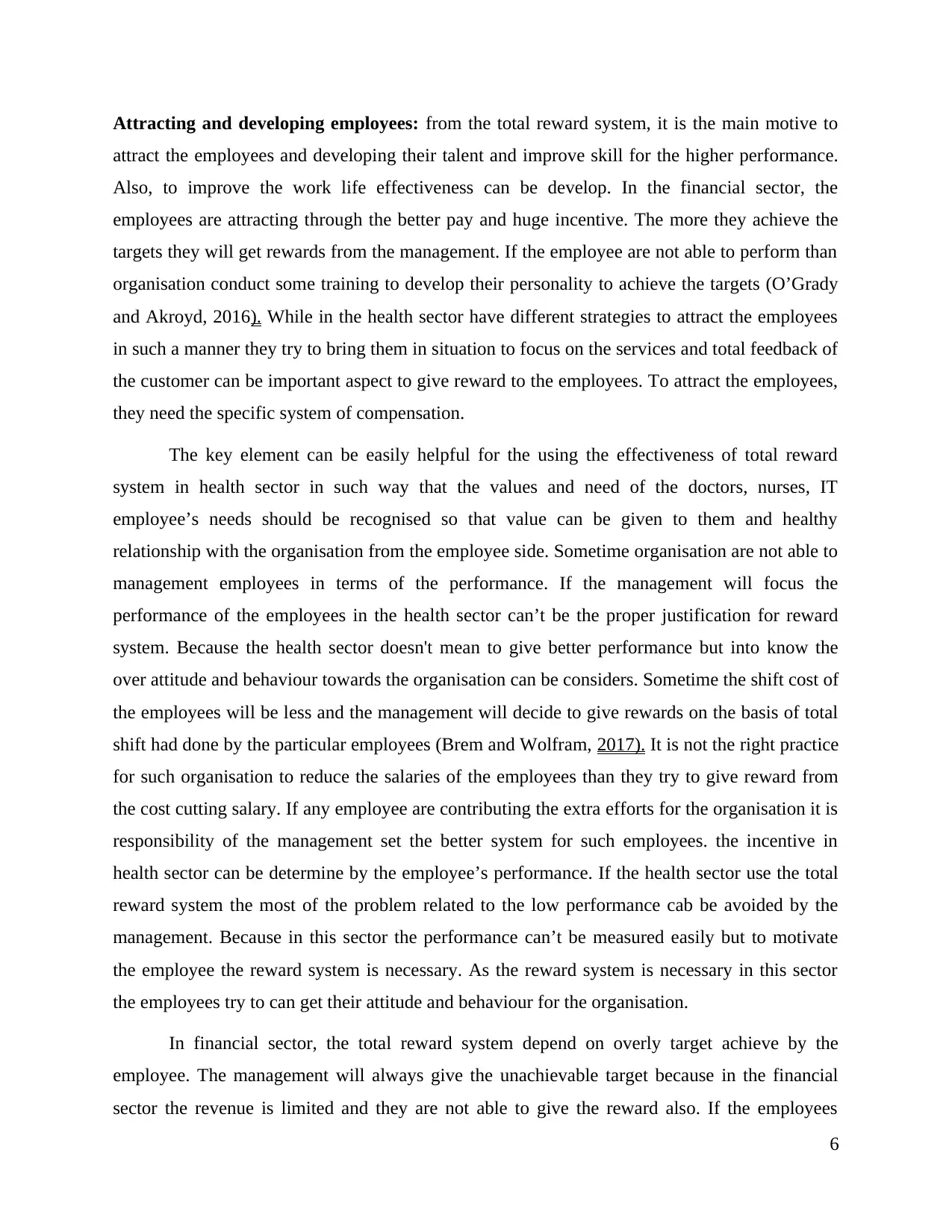
Attracting and developing employees: from the total reward system, it is the main motive to
attract the employees and developing their talent and improve skill for the higher performance.
Also, to improve the work life effectiveness can be develop. In the financial sector, the
employees are attracting through the better pay and huge incentive. The more they achieve the
targets they will get rewards from the management. If the employee are not able to perform than
organisation conduct some training to develop their personality to achieve the targets (O’Grady
and Akroyd, 2016). While in the health sector have different strategies to attract the employees
in such a manner they try to bring them in situation to focus on the services and total feedback of
the customer can be important aspect to give reward to the employees. To attract the employees,
they need the specific system of compensation.
The key element can be easily helpful for the using the effectiveness of total reward
system in health sector in such way that the values and need of the doctors, nurses, IT
employee’s needs should be recognised so that value can be given to them and healthy
relationship with the organisation from the employee side. Sometime organisation are not able to
management employees in terms of the performance. If the management will focus the
performance of the employees in the health sector can’t be the proper justification for reward
system. Because the health sector doesn't mean to give better performance but into know the
over attitude and behaviour towards the organisation can be considers. Sometime the shift cost of
the employees will be less and the management will decide to give rewards on the basis of total
shift had done by the particular employees (Brem and Wolfram, 2017). It is not the right practice
for such organisation to reduce the salaries of the employees than they try to give reward from
the cost cutting salary. If any employee are contributing the extra efforts for the organisation it is
responsibility of the management set the better system for such employees. the incentive in
health sector can be determine by the employee’s performance. If the health sector use the total
reward system the most of the problem related to the low performance cab be avoided by the
management. Because in this sector the performance can’t be measured easily but to motivate
the employee the reward system is necessary. As the reward system is necessary in this sector
the employees try to can get their attitude and behaviour for the organisation.
In financial sector, the total reward system depend on overly target achieve by the
employee. The management will always give the unachievable target because in the financial
sector the revenue is limited and they are not able to give the reward also. If the employees
6
attract the employees and developing their talent and improve skill for the higher performance.
Also, to improve the work life effectiveness can be develop. In the financial sector, the
employees are attracting through the better pay and huge incentive. The more they achieve the
targets they will get rewards from the management. If the employee are not able to perform than
organisation conduct some training to develop their personality to achieve the targets (O’Grady
and Akroyd, 2016). While in the health sector have different strategies to attract the employees
in such a manner they try to bring them in situation to focus on the services and total feedback of
the customer can be important aspect to give reward to the employees. To attract the employees,
they need the specific system of compensation.
The key element can be easily helpful for the using the effectiveness of total reward
system in health sector in such way that the values and need of the doctors, nurses, IT
employee’s needs should be recognised so that value can be given to them and healthy
relationship with the organisation from the employee side. Sometime organisation are not able to
management employees in terms of the performance. If the management will focus the
performance of the employees in the health sector can’t be the proper justification for reward
system. Because the health sector doesn't mean to give better performance but into know the
over attitude and behaviour towards the organisation can be considers. Sometime the shift cost of
the employees will be less and the management will decide to give rewards on the basis of total
shift had done by the particular employees (Brem and Wolfram, 2017). It is not the right practice
for such organisation to reduce the salaries of the employees than they try to give reward from
the cost cutting salary. If any employee are contributing the extra efforts for the organisation it is
responsibility of the management set the better system for such employees. the incentive in
health sector can be determine by the employee’s performance. If the health sector use the total
reward system the most of the problem related to the low performance cab be avoided by the
management. Because in this sector the performance can’t be measured easily but to motivate
the employee the reward system is necessary. As the reward system is necessary in this sector
the employees try to can get their attitude and behaviour for the organisation.
In financial sector, the total reward system depend on overly target achieve by the
employee. The management will always give the unachievable target because in the financial
sector the revenue is limited and they are not able to give the reward also. If the employees
6
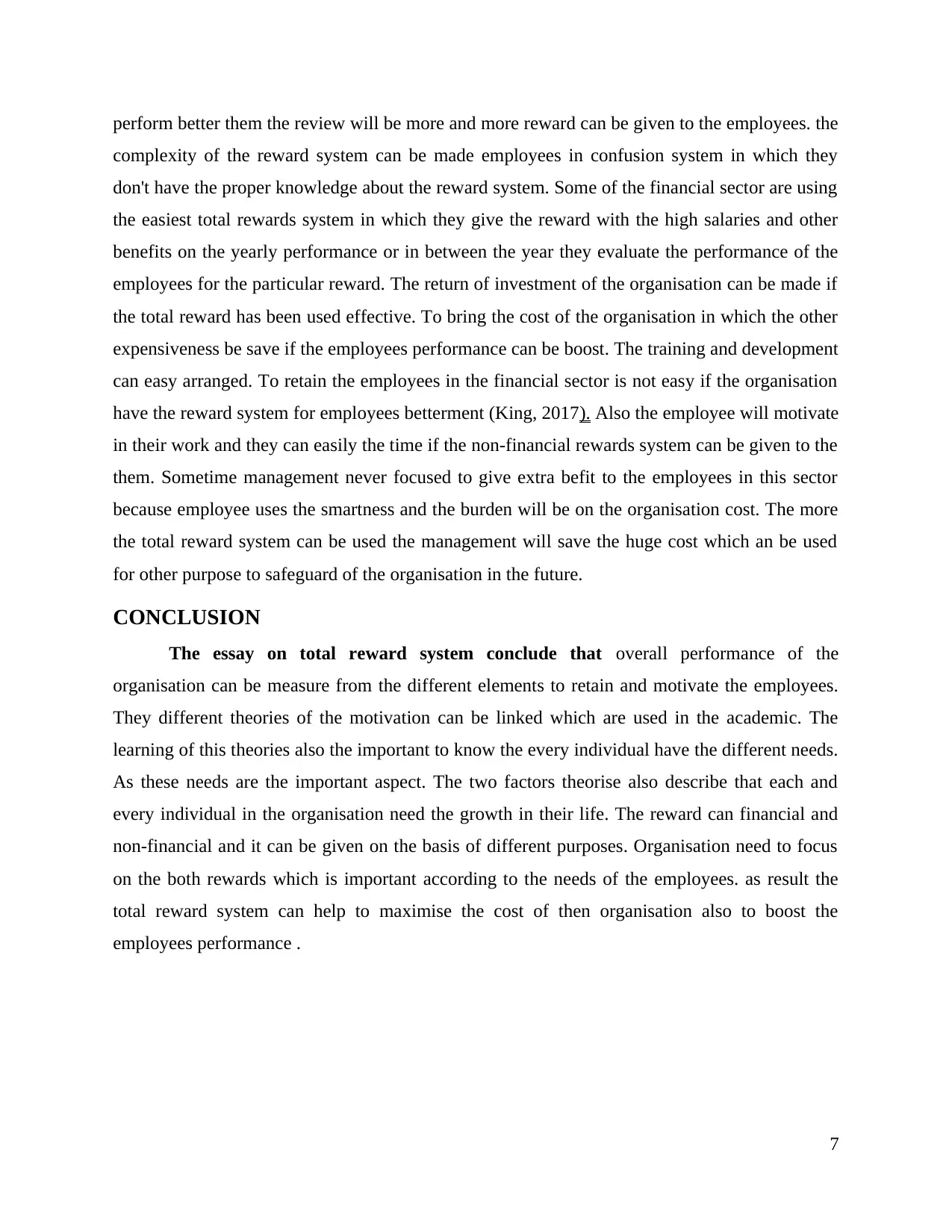
perform better them the review will be more and more reward can be given to the employees. the
complexity of the reward system can be made employees in confusion system in which they
don't have the proper knowledge about the reward system. Some of the financial sector are using
the easiest total rewards system in which they give the reward with the high salaries and other
benefits on the yearly performance or in between the year they evaluate the performance of the
employees for the particular reward. The return of investment of the organisation can be made if
the total reward has been used effective. To bring the cost of the organisation in which the other
expensiveness be save if the employees performance can be boost. The training and development
can easy arranged. To retain the employees in the financial sector is not easy if the organisation
have the reward system for employees betterment (King, 2017). Also the employee will motivate
in their work and they can easily the time if the non-financial rewards system can be given to the
them. Sometime management never focused to give extra befit to the employees in this sector
because employee uses the smartness and the burden will be on the organisation cost. The more
the total reward system can be used the management will save the huge cost which an be used
for other purpose to safeguard of the organisation in the future.
CONCLUSION
The essay on total reward system conclude that overall performance of the
organisation can be measure from the different elements to retain and motivate the employees.
They different theories of the motivation can be linked which are used in the academic. The
learning of this theories also the important to know the every individual have the different needs.
As these needs are the important aspect. The two factors theorise also describe that each and
every individual in the organisation need the growth in their life. The reward can financial and
non-financial and it can be given on the basis of different purposes. Organisation need to focus
on the both rewards which is important according to the needs of the employees. as result the
total reward system can help to maximise the cost of then organisation also to boost the
employees performance .
7
complexity of the reward system can be made employees in confusion system in which they
don't have the proper knowledge about the reward system. Some of the financial sector are using
the easiest total rewards system in which they give the reward with the high salaries and other
benefits on the yearly performance or in between the year they evaluate the performance of the
employees for the particular reward. The return of investment of the organisation can be made if
the total reward has been used effective. To bring the cost of the organisation in which the other
expensiveness be save if the employees performance can be boost. The training and development
can easy arranged. To retain the employees in the financial sector is not easy if the organisation
have the reward system for employees betterment (King, 2017). Also the employee will motivate
in their work and they can easily the time if the non-financial rewards system can be given to the
them. Sometime management never focused to give extra befit to the employees in this sector
because employee uses the smartness and the burden will be on the organisation cost. The more
the total reward system can be used the management will save the huge cost which an be used
for other purpose to safeguard of the organisation in the future.
CONCLUSION
The essay on total reward system conclude that overall performance of the
organisation can be measure from the different elements to retain and motivate the employees.
They different theories of the motivation can be linked which are used in the academic. The
learning of this theories also the important to know the every individual have the different needs.
As these needs are the important aspect. The two factors theorise also describe that each and
every individual in the organisation need the growth in their life. The reward can financial and
non-financial and it can be given on the basis of different purposes. Organisation need to focus
on the both rewards which is important according to the needs of the employees. as result the
total reward system can help to maximise the cost of then organisation also to boost the
employees performance .
7
⊘ This is a preview!⊘
Do you want full access?
Subscribe today to unlock all pages.

Trusted by 1+ million students worldwide
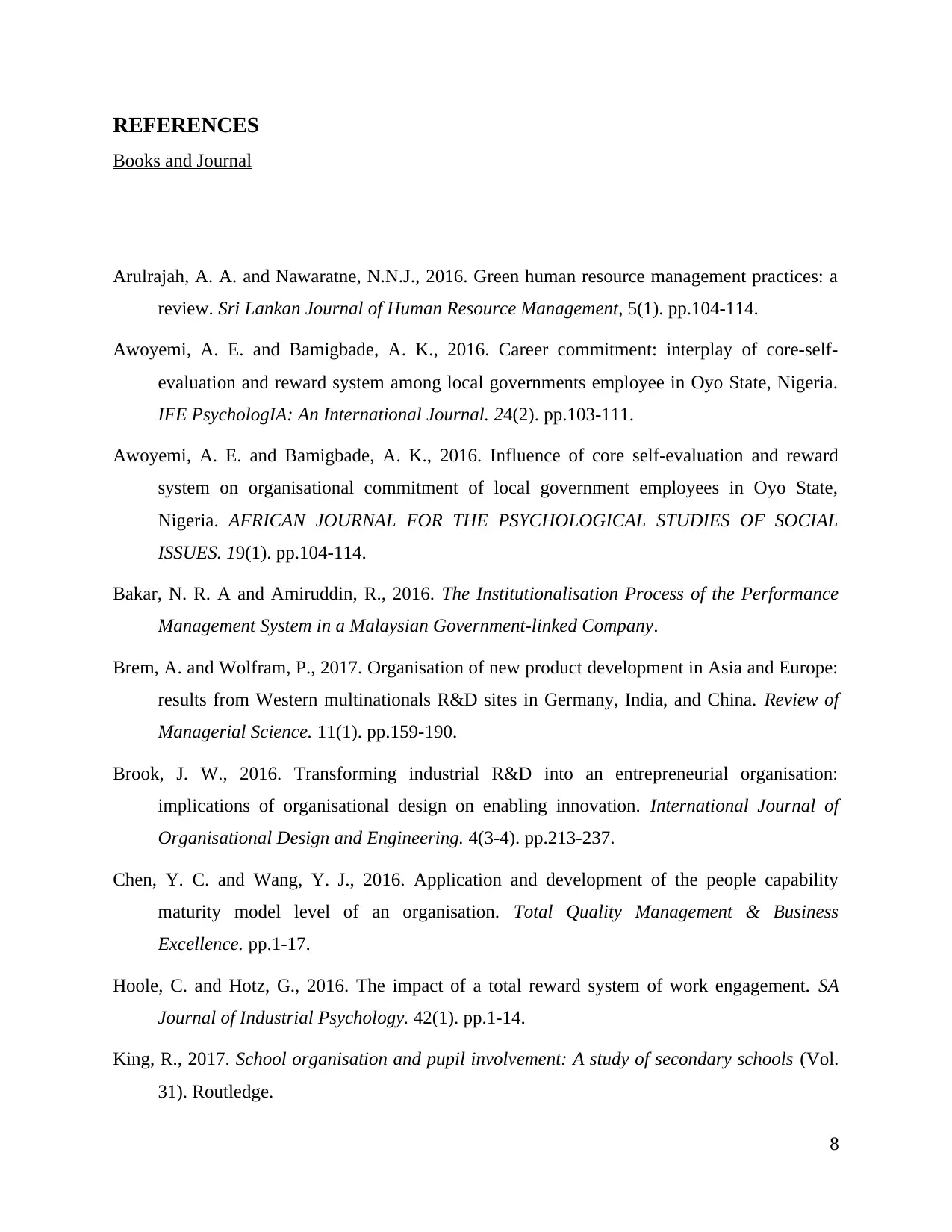
REFERENCES
Books and Journal
Arulrajah, A. A. and Nawaratne, N.N.J., 2016. Green human resource management practices: a
review. Sri Lankan Journal of Human Resource Management, 5(1). pp.104-114.
Awoyemi, A. E. and Bamigbade, A. K., 2016. Career commitment: interplay of core-self-
evaluation and reward system among local governments employee in Oyo State, Nigeria.
IFE PsychologIA: An International Journal. 24(2). pp.103-111.
Awoyemi, A. E. and Bamigbade, A. K., 2016. Influence of core self-evaluation and reward
system on organisational commitment of local government employees in Oyo State,
Nigeria. AFRICAN JOURNAL FOR THE PSYCHOLOGICAL STUDIES OF SOCIAL
ISSUES. 19(1). pp.104-114.
Bakar, N. R. A and Amiruddin, R., 2016. The Institutionalisation Process of the Performance
Management System in a Malaysian Government-linked Company.
Brem, A. and Wolfram, P., 2017. Organisation of new product development in Asia and Europe:
results from Western multinationals R&D sites in Germany, India, and China. Review of
Managerial Science. 11(1). pp.159-190.
Brook, J. W., 2016. Transforming industrial R&D into an entrepreneurial organisation:
implications of organisational design on enabling innovation. International Journal of
Organisational Design and Engineering. 4(3-4). pp.213-237.
Chen, Y. C. and Wang, Y. J., 2016. Application and development of the people capability
maturity model level of an organisation. Total Quality Management & Business
Excellence. pp.1-17.
Hoole, C. and Hotz, G., 2016. The impact of a total reward system of work engagement. SA
Journal of Industrial Psychology. 42(1). pp.1-14.
King, R., 2017. School organisation and pupil involvement: A study of secondary schools (Vol.
31). Routledge.
8
Books and Journal
Arulrajah, A. A. and Nawaratne, N.N.J., 2016. Green human resource management practices: a
review. Sri Lankan Journal of Human Resource Management, 5(1). pp.104-114.
Awoyemi, A. E. and Bamigbade, A. K., 2016. Career commitment: interplay of core-self-
evaluation and reward system among local governments employee in Oyo State, Nigeria.
IFE PsychologIA: An International Journal. 24(2). pp.103-111.
Awoyemi, A. E. and Bamigbade, A. K., 2016. Influence of core self-evaluation and reward
system on organisational commitment of local government employees in Oyo State,
Nigeria. AFRICAN JOURNAL FOR THE PSYCHOLOGICAL STUDIES OF SOCIAL
ISSUES. 19(1). pp.104-114.
Bakar, N. R. A and Amiruddin, R., 2016. The Institutionalisation Process of the Performance
Management System in a Malaysian Government-linked Company.
Brem, A. and Wolfram, P., 2017. Organisation of new product development in Asia and Europe:
results from Western multinationals R&D sites in Germany, India, and China. Review of
Managerial Science. 11(1). pp.159-190.
Brook, J. W., 2016. Transforming industrial R&D into an entrepreneurial organisation:
implications of organisational design on enabling innovation. International Journal of
Organisational Design and Engineering. 4(3-4). pp.213-237.
Chen, Y. C. and Wang, Y. J., 2016. Application and development of the people capability
maturity model level of an organisation. Total Quality Management & Business
Excellence. pp.1-17.
Hoole, C. and Hotz, G., 2016. The impact of a total reward system of work engagement. SA
Journal of Industrial Psychology. 42(1). pp.1-14.
King, R., 2017. School organisation and pupil involvement: A study of secondary schools (Vol.
31). Routledge.
8
Paraphrase This Document
Need a fresh take? Get an instant paraphrase of this document with our AI Paraphraser
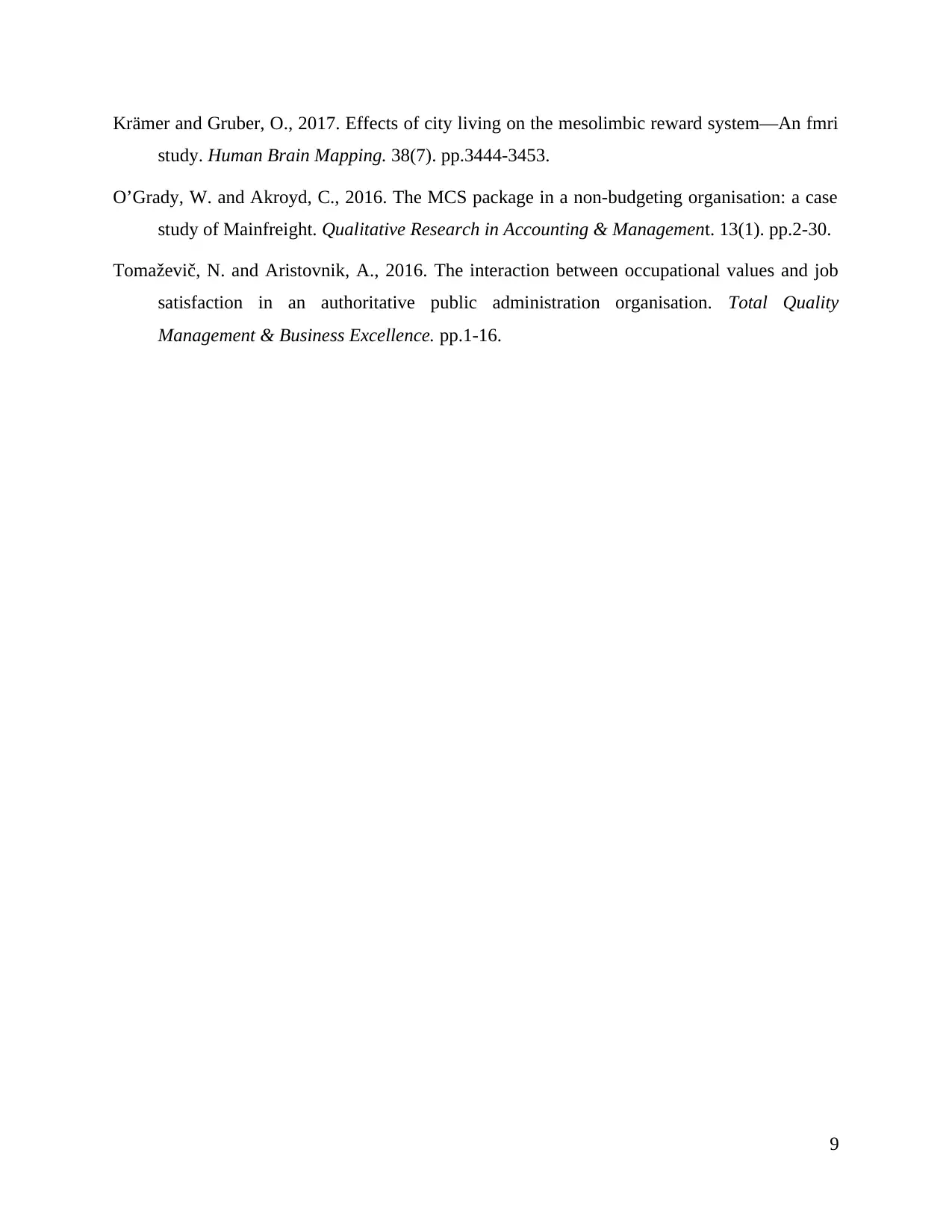
Krämer and Gruber, O., 2017. Effects of city living on the mesolimbic reward system—An fmri
study. Human Brain Mapping. 38(7). pp.3444-3453.
O’Grady, W. and Akroyd, C., 2016. The MCS package in a non-budgeting organisation: a case
study of Mainfreight. Qualitative Research in Accounting & Management. 13(1). pp.2-30.
Tomaževič, N. and Aristovnik, A., 2016. The interaction between occupational values and job
satisfaction in an authoritative public administration organisation. Total Quality
Management & Business Excellence. pp.1-16.
9
study. Human Brain Mapping. 38(7). pp.3444-3453.
O’Grady, W. and Akroyd, C., 2016. The MCS package in a non-budgeting organisation: a case
study of Mainfreight. Qualitative Research in Accounting & Management. 13(1). pp.2-30.
Tomaževič, N. and Aristovnik, A., 2016. The interaction between occupational values and job
satisfaction in an authoritative public administration organisation. Total Quality
Management & Business Excellence. pp.1-16.
9
1 out of 11
Related Documents
Your All-in-One AI-Powered Toolkit for Academic Success.
+13062052269
info@desklib.com
Available 24*7 on WhatsApp / Email
![[object Object]](/_next/static/media/star-bottom.7253800d.svg)
Unlock your academic potential
Copyright © 2020–2025 A2Z Services. All Rights Reserved. Developed and managed by ZUCOL.





